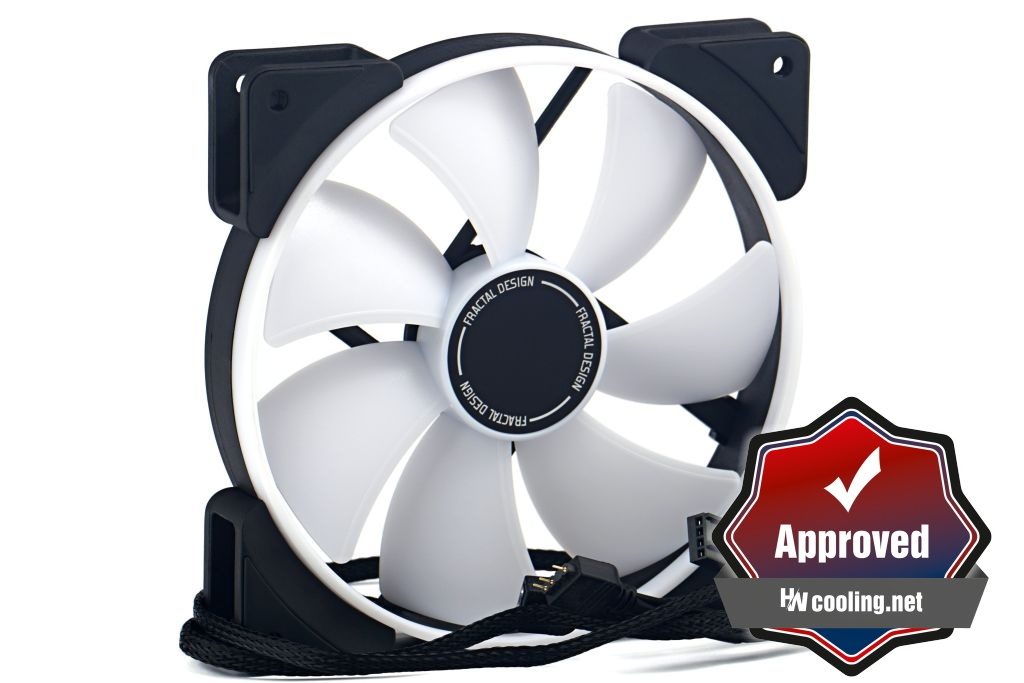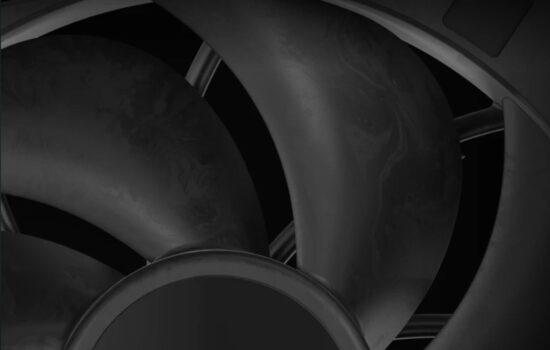Evaluation
Fractal Design claims the Prisma models as its most efficient 140mm fans. According to the specs, they are supposed to achieve the highest airflow at a lower noise level than the Aspect 14s. However, this is physically impossible due to the constructional differences of the two fans. The title of the article has a bit of a pejorative tone and while the Prisma AL-14 PWM is a decent fan, it already has a superior from its own ranks.
In order not to give the impression that the Prisma AL-14 PWM is a worse fan than it actually is, we will start the review by stating the positive features. There are certainly more of these than there are negatives.
In very low resistance environments, typically with no obstacle, the efficiency (airflow to noise ratio) is at the level of high-end 120 mm fans. On a plastic filter, the Prisma AL-14 PWM clearly outperforms them at higher than very low speeds (from about 740 rpm). But then again, like the other 140mm fans we’ve tested so far. The advantage of the AL-14 PWM over most of them is that it doesn’t transmit any vibration. That is, the vibrations are so low that they are absorbed by the anti-vibration pads and at a location behind the fan (typically on the case or cooler radiator). The results show nicely what the Aspect 14 RGB PWM loses by not using these damping pads. Vibration is always low with this geometry, but the Prisma AL-14 PWM is definitely better, and among 140mm fans it is only matched by a few high-end models and for example the Aorus 140 ARGB.
But there’s one thing for which most users will probably prefer the Aspect 14 RGB PWM (over the Prisma AL-14 PWM). And that’s the whirring motor (peaking at 1208 Hz), for which in quieter modes, the Prisma fan has fallen behind the Aspect quite a lot. That’s because the lower the rpm, the more the unwanted engine noise makes up a greater proportion of the same noise level, leaving less and less room for the aerodynamic component. This rattle is quite annoying, but still a noticeably weaker one than the Cooler Master SickleFlow 120 ARGB, which doesn’t lose the lead in this discipline.
The whirring is a characteristic of the motor used. The same one was used in the early batches (from 2019) as well as now, the current one. It is probably not impossible that some pieces have a different motor (from Aspects, for example) and don’t whirr, but we didn’t come across such a thing and all seven pieces we had available for testing behaved the same way. This is a bit of a shame and the biggest weakness of an otherwise attractive fan. The more annoying motor noise dies down only at very low speeds (from about 450 rpm below, to 155 rpm representing the operating minimum), which are below the PWM range, so DC control is essential to achieve them.
The advantage of the motor in the Prisma AL-14 PWM is that it is significantly more powerful compared to the one in the Aspect 14 RGB PWM. This mainly means that it can better compensate for the aerodynamic resistance of an obstacle and holds the set speed more steadily. And among other things, the higher MTBF value, which is 10,000 hours higher for the Prisma fan, may also be due to its use. The plain bearings are basically what both FD fans have, but while the Aspect 14 RGB PWM will be long out of action, the Prisma AL-14 PWM Prisma will still work somehow. Sure, the operation won’t be optimal anymore, but air will still drive the fan even after significant wear (typically hardening of the lubricant).
Either way though, from the comparison with the Aspect 14 RGB PWM, a number of elements point to how over time Fractal Design has located the weaknesses of the Prisma fans and no longer carried them over to the Aspects, and improved other things. This is also the case, for example, when it comes to lighting, the brightness of which is significantly higher at the same power draw. This is also achieved by more efficient light conduction through the fan body. And that’s at the same time as it’s more elegantly diffused, without the dot trails of individual LEDs, which are quite visible around the motor on the Prisma fan.
The Prisma AL-14 is a more expensive fan to manufacture (that’s because of the two-piece tunnel, among other things), but most users will find the Aspects more attractive. However, it is still true that at higher speeds (where the whirring of the motor is overcome by aerodynamic noise) at the same noise level, the Prisma AL-14 beats even the Aorus 140 RGB with ease even on a radiator, where the Prisma fan does not dominate. Compared to the 140mm BeQuiet Light Wings, except for application on radiators, does not acoustically disturb by resonating at lower sound frequencies. There are reasons why the Prisma AL-14 might be a good choice for someone even today, but they need to be weighed carefully, especially when compared to the Aspect 14 RGB PWM.
English translation and edit by Jozef Dudáš
| Fractal Design Prisma AL-14 PWM |
| + Suitable for any scenario |
| + Cooling efficiency (airflow/pressure per unit of noise) at a high level |
| + Sometimes beats even the most efficient 120 mm models as a system fan at low speed |
| + Very high effectiveness even with dust filters |
| + Wide speed range |
| + Zero vibration across the entire speed spectrum |
| + Rotor lighting |
| + Really powerful motor |
| - Rattling motor |
| - Given the size of the blades, the material used is too thin... |
| - ... because of this, resonant frequencies are stimulated, especially on radiators |
| - Higher minimum speed (~ 514 rpm) via PWM |
| - Does not support passive mode, does not "switch off" at low PWM intensity |
| Approximate retail price: 21 EUR |
- Contents
- Fractal Design Prisma AL-14 PWM in detail
- Basis of the methodology, the wind tunnel
- Mounting and vibration measurement
- Initial warm-up and speed recording
- Base 6 equal noise levels…
- ... and sound color (frequency characteristic)
- Static pressure measurement…
- … and airflow
- Everything changes with obstacles
- How we measure power draw and motor power
- Measuring the intensity (and power draw) of lighting
- Results: Speed
- Results: Airlow w/o obstacles
- Results: Airflow through a nylon filter
- Results: Airflow through a plastic filter
- Results: Airflow through a hexagonal grille
- Results: Airflow through a thinner radiator
- Results: Airflow through a thicker radiator
- Results: Static pressure w/o obstacles
- Results: Static pressure through a nylon filter
- Results: Static pressure through a plastic filter
- Results: Static pressure through a hexagonal grille
- Results: Static pressure through a thinner radiator
- Results: Static pressure through a thicker radiator
- Results: Static pressure, efficiency by orientation
- Reality vs. specifications
- Results: Frequency response of sound w/o obstacles
- Results: Frequency response of sound with a dust filter
- Results: Frequency response of sound with a hexagonal grille
- Results: Frequency response of sound with a radiator
- Results: Vibration, in total (3D vector length)
- Results: Vibration, X-axis
- Results: Vibration, Y-axis
- Results: Vibration, Z-axis
- Results: Power draw (and motor power)
- Results: Cooling performance per watt, airflow
- Results: Cooling performance per watt, static pressure
- Airflow per euro
- Static pressure per euro
- Results: Lighting – LED luminance and power draw
- Results: LED to motor power draw ratio
- Evaluation












